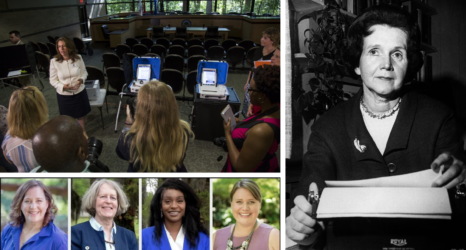We unreasonably expect Black girls to “jump up in the air and stay there.”

“Literally cannot tell up from down. It’s the craziest feeling ever. Not having an inch of control over your body. What’s even scarier is since I have no idea where I am in the air I also have NO idea how I’m going to land, or what I’m going to land on. Head/hands/feet/back.”
—Simone Biles
“I know you want to/reach to the higher level/
much further from the devil/
until you feel the weather.
I know you want to/Jump up in the air and stay there”
—Erykah Badu
“If you surrendered to the air, you could ride it.”
—Toni Morrison, Song of Solomon
The day after I finished my final stop on the book tour for Eloquent Rage, I woke up in my bed at 4 or 5 a.m. with the room spinning. My impulse was to move from laying to sitting to standing—anything to stop the room from moving. Standing up seemed to work. When I tried to lay back down, the room started spinning again. And for over six months after that, I did not sleep in my own bed, or any bed, anywhere, because having pushed myself at a literal dizzying pace for so long, my body, though exhausted, was uncomfortable, it seems, with anything akin to rest.
It took about three months to get a diagnosis. I essentially had two kinds of vertigo that had apparently collided. In one, the tiny crystals that rest in your inner ears to maintain balance had migrated to some place they weren’t supposed to be. Three months of doing a couple of different versions of the Epley Maneuver with a physical therapist was designed to use gravity to get those crystals back to their rightful place.
But my ear, nose and throat doctor also discovered, after a horrid in-office test in which they induce vertigo to see what the problem might be, that my entire vestibular system, the system responsible for controlling physical balance, was weak.
My left side was overperforming in keeping my balance, while my right side was underperforming, working only at about 70 percent. The issues I had with lack of rest and lack of “work-life balance” had manifested in ways that were medically measurable. Thus the physical therapist spent the rest of that three months trying to rehabilitate my brain, with a series of hand-eye coordination exercises to strengthen my weak side, allowing it to do more of its job.
During my many sessions of PT, my therapist often asked me about the particulars of when I would lose balance. One thing I had noticed is that if I were laying feet outstretched, but partially upright on my big lounge chair, when I went to turn, I often felt immediately off-kilter. She explained that I also had “weak proprioception.” The brain, she said, used the feet to determine the positionality of the whole body. With proprioception being weak, whenever my feet moved from a resting position, my body’s GPS essentially went into searching mode, trying to figure out its place in space.
When Simone Biles shared her struggles with “the twisties,” a terrible sensation, in which she didn’t know where she was in the air, the closest bodily experience I could conjure was this struggle with vertigo and a weak vestibular system. To be clear, I am no athlete—despite that one summer of gymnastics camp when I was 11—and I’m sure that my struggle to stay upright on the ground is barely comparable to what it means to understand where one is in the air.
Still, Simone Biles’s plight felt to me like both metaphor and matterphor for Black ascension—a kind of disorientation that attends to Black excellence, the discomfiture that comes in those fleeting moments, where having pulled off something great, you feel like you are on top of the world, and yet, curiously, terrifyingly, you also have no idea where you are in the air.
I sensed in those months when I could not simply lie down and get a good night’s rest in my own bed, a clear directive from my body, that all of my hustle and grind and shine, had thrown it into chaos. My body did not know how to come down from what felt like a personal “on top of the world experience.” I knew how to go, stand and speak, but not how to rest. My brain needed actual re-training.
Still, I sometimes get lessons slowly, especially when it comes to matters of ambition, and that driving need, having grown up working class with the dreams of a whole community at my back, to be somebody. So one year later, after another intense season of travel, I mentioned to a good friend, a priest and medium, at a conference, that every time I got on airplanes I had started to feel claustrophobic. Back to me, she simply said that a female ancestor of mine was showing her that I needed to put my foot in the soil of home. I knew what it meant, a spiritual confirmation of something my own weak proprioception and foot searching for my place in the air had shown me a year earlier. I needed to slow down. To ground myself. To remember who I was.
I sensed in those months when I could not simply lie down and get a good night’s rest in my own bed, a clear directive from my body, that all of my hustle and grind and shine, had thrown it into chaos.
Or I would keep on losing my place in the air. My head, the place that houses my eyes and ears, would not know what to do or where to go, if my feet couldn’t find the ground.
I don’t know that this is Simone Biles’s lesson. She lives in the air. But that sense she recounted that she lost herself in the midst of doing something it seems like God herself put Simone here to do, felt…resonant.
The fear of not knowing how to land. Where you would land. Whether you would land on your feet or fall so hard that it might kill you.
That thing where Black women overperform getting up, but underperform on lying down.
Any of us who have to take big leaps to do things we’ve never seen others do before get the visceral fear on some level, the potential for a mind/body disconnect. That space between leaping and landing is entirely vestibular. Vulnerable. Worthy of empathy.
My episodic run-ins with an unhappy vestibular system over the last three years—always my body’s signal that I am in fact doing the most—also made me revisit the classic essay in Black letters, Hortense Spillers’ “Mama’s Baby, Papa’s Maybe: An American Grammar Book,” wherein she theorizes the “cultural vestibularity” at the heart of Black women’s experience of U.S. empire.
Spillers formulated a notion of cultural vestibularity as a way to think about the Middle Passage, the slave ship, and the distinction between Black flesh and Black bodies, as all matters relegated to the antechambers of American life, the space of initial entry, the before-times.
When I first read that essay, I always conjured up the old church vestibule of my youth, where solicitous (and judgy) ushers, with white gloved hands whispered harried instructions loudly to the crowds of johnny-come-lately churchgoers, smashed together, pantyhose rustling, ill-fitting suits and tight church shoes pinching, trying to be silent and reverent, despite the bodily disruption portended by all of us being together there huddled in the outer halls of the church, waiting, waiting, waiting to be let in … ushered in.
The vestibule was a channel, an entry point into a large system of sociality and social relations.
But having read Biles recounting of losing her place in the air, and thinking of my own tricky vestibular system, Spillers hit different.
Being rocked in the belly of a slave ship certainly induced vertigo for some of our ancestors. I’m sure none of them related to the ground, the air, or the water, the same way ever again.
I am thinking less these days about what happens in the antechambers of American life and thinking more about the intricate channels and tunnels of Black life—the ways that being rocked in the belly of a slave ship certainly induced vertigo for some of our ancestors. I’m sure none of them related to the ground, the air, or the water, the same way ever again.
I am also thinking that while Biles seems like magic to the rest of us, the feats she achieves are done by a material flesh and blood body. Simone Biles is not merely our idea of her … she is some body. A body to invoke Spillers’s with its own hieroglyphics of the flesh, having been subjected to untold levels of sexual violence and bodily injury during her entire career, in service of our shared moments of collective awe and ecstasy.
Simone Biles has a body with a vestibular system, a material flesh and blood entity, that seemingly gives way, sometimes, losing its place in the air. This is not a metaphor.
So where then do we land? How? How do we do it? Collectively and individually, having lost our place in the air. This is the question that attends to an American Empire on the decline. This is a question of cultural vestibularity that attends to the Black women and girls dispatched from the belly of the beast to try to rescue us from a surely coming end.
Black women will continue to be the crystals out of place in the vestibular life of America, and there is no Epley Maneuver to fix that. We will continue to disorient the nation, to vertiginous ends, our purpose never having been to make America soar above all others, the consequences of our defiant brilliance, only incidentally having done that. Our job, having been shoehorned into places unintended for us, was always to keep the system we were injected into off balance.
In short, I am concerned with, I suppose, but unbothered by how or where America lands.
Only Black girls. And for us, I say, gravity. The ability to find the ground, to stick the landing on your own terms, is always the goal.
Simone Biles has embodied this sacred Morrisonian scripture: “if you surrendered to the air, you could ride it.” But we unreasonably expect Black girls to “jump up in the air and stay there.”
In the end, though, there is only air and gravity, the space between the leap and the land. Gravity and its intractable pull downward helps us to respect what it means to find our place in the air. And then to land. Feet first. And stand our ground.
This post originally appeared on the Remix on August 2, 2021. It has been republished with permission.
Up next:





